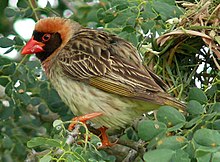Quelea quelea
| Red-billed quelea | |
|---|---|
 |
|
| Male Q. q. athamii, South Africa | |
| Scientific classification | |
| Kingdom: | Animalia |
| Phylum: | Chordata |
| Class: | Aves |
| Order: | Passeriformes |
| Family: | Ploceidae |
| Genus: | Quelea |
| Species: | Q. quelea |
| Binomial name | |
|
Quelea quelea (Linnaeus, 1758) |
|
The red-billed quelea (Quelea quelea), also known as the red-billed weaver or red-billed dioch, is the world's most abundant wild bird species, with an estimated adult breeding population of 1.5 billion pairs. Some estimates of the overall population have been as large as 10 billion. The entire population is found in sub-Saharan Africa and is generally absent from thickly forested regions and the southern reaches of South Africa. It is a small passerine bird of the weaver family, Ploceidae.
Red-billed quelea are small birds and average-sized weaver-finches. They grow to 11–13 cm (4.5–5 in) long and attain a weight of 15 to 20 g (0.5-0.7 oz). During the breeding stage, the adult male is distinguished by his more colorful plumage and red bill. Breeding plumage in male queleas is unusually variable, comprising a facial mask which ranges from black to white in color, and breast and crown plumage which varies from yellowish to bright red. For the rest of the year, both males and fledged nonbreeding birds have plumage that resembles that of the adult female, which is overall a cryptic beige and cream coloration. The female's bill is yellow during breeding, and red during the nonbreeding season. Flocks of red-billed quelea can reach thousands of birds.
Male Q. q. aethiopica with pink breeding plumage
Kyambura Game Reserve, Uganda
Male Q. q. aethiopica with yellow breeding plumage
Kyambura Game Reserve, Uganda
flocking
The distribution area of the red-billed quelea covers the majority of sub-Saharan Africa, excluding deep portions of rain forest in central Africa. It is also generally absent from the southern portion of South Africa. It was introduced to Reunion in 2000.
Red-billed queleas live and breed in huge flocks which can take up to 5 hours to fly past. They live mostly in steppe and savanna regions, but do not avoid human settlements. While foraging for food, they may fly large distances each day without tiring. Their life expectancy is two to three years.
...
Wikipedia

